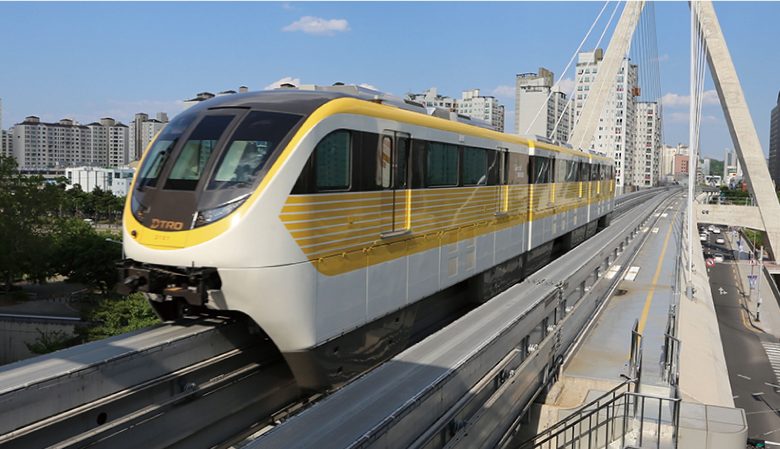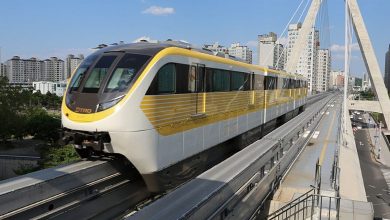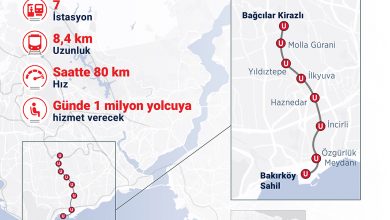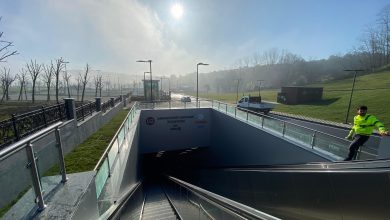Comparison of Monorail and the other Railway Systems
MONORAILS AND COMPARISON WITH THE OTHER RAILWAY SYSTEMS 3. Uluslararası Raylı Sistemler Mühendisliği Sempozyumu (ISERSE’16), 13-15 Ekim 2016, Karabük, Türkiye

ÖZET [TR] Dünya genelinde öncelikli olarak kısa mesafeli, lokal bir taşımacılık çözümü olarak ortaya çıktığı görülen ancak gün geçtikçe yaygınlaşan bir kullanım alanı bulan monoray sistemleri, son dönemde ülkemizde de proje çalışmalarına başlanan “Havaray” uygulamaları ile gündemde yerini almıştır. Monoray sistemleri ayrıcalıklı yol kullanım hakkına sahip olup, hızlı toplu tasıma sistemleri arasına dâhil edilmektedir. Bir ray veya kiriş üzerinde giden kavramalı sistemler veya ray/kirişe asılı olan askılı sistemleri klavuzlu olma özelligi sebebiyle birçok raylı sistem hattıyla benzerlik gösteriyor olsa da yapım ve işletme özellikleri açısından belli farklılıklar içermektedir. Bu çalışma kapsamında monoray sistemlerinin çeşitleri ve işletme karakteristiklerinden bahsedilecek, diğer raylı sistem ile yapım ve işletme maliyetleri ve toplu taşımacılıkta kapasite açısından karşılaştırmaları yapılarak kullanımının ne koşullarda uygun ve avantajlı olacağı değerlendirilecektir.
ABSTRACT [EN] Monorail s, which are sort out just as a local transportation system but widened day by day with many different projects around the world and also take place on the agenda for Turkey with planning monorail (railway) projects. Because of having privileged way opportunities, monorails became a member of fast public transportation systems. These two kinds of straddle-type and suspended-type monorail systems have commonalities with the other railways as a track system but also some differences in construction and operating characteristics. In the scope of this study we will talk about monorail system types and their operating characteristics, compare them with the other railway systems in construction and operation costs and evaluate in which conditions monorail systems are convenient and advantageous.
1. Introduction
Although the monorail system was first used as a transportation system at amusement parks and fairs, currently it is preferred in many large-scale public transportation projects. One of the leading countries in terms of rail transit systems around the world and has successfully operated lines; Kitakyushu, Chiba, Osaka, Tama, Tokyo-Haneda, Shonan, and Naha-Okinawa, Japan also lead in the monorail systems. Except for Japan, it is known that many Asian countries; Kuala Lumpur, Malaysia, Singapore, South Korea, China, Thailand, Dubai, India, and also America, Europe, and Australia have many monorail lines in different capacities and have many new projects to build.
In Turkey, it is known that being late to have this technology but in the light of the last 15 years’ significantly
increasing rail transit system investments, it is promising to catch up with realistic survey works and applications. On the other hand, this should also be considered that monorail systems are used around the world with specific lines and specific locations, so it is not an obligation that has a monorail system but this is also a fact that it has many advantages in several ways.
2. Monorail Systems
The first generally recognized monorail was the Schwebebahn (“swaying railroad”) in Wuppertal, Germany. A single steel rail is suspended from an elevated structure along which a single rail runs. In this instance, the vehicle weight is both supported by the rail and guided by it. Modern versions of the Schwebebahn monorail look similar in that the monorail is suspended from above. However, instead of using a single rail for support and guidance, the single rail is replaced by a hollowed-out concrete or steel beam, and rubber tires are used instead of metal wheels. Although this is the most common configuration, numerous combinations of steel or concrete running surfaces and rubber tires or steel wheels—both singly and doubly flanged have been proposed.[1]
Monorails are classified into straddle and suspended-type systems. Since the straddle-type travels by straddling the track, its center of gravity is situated above the track. The suspended-type, on the other hand, is configured suspending from the track, with its center of gravity under the track.
- Straddle-type Monorail System
Straddle-type has the widest usage among the monorail systems because of being the most suitable system for the environment visually.
Straddle-type monorails are composed of a train and a narrow reinforced concrete or steel trackway. Trains carrier rubber wheels go on the trackway and the guide rubber wheels press both sides of the beam. Although there are some different configurations but these all have the same principle.
- Suspended-type Monorail System;
Bogie moves within the inside bottom face of a box-shaped empty beam and suspension pass through the beam. System has quiet and smooth acceleration-deceleration properties like subway and ALWEG(A German Company) type trains. Trains are hung with a pendulum-type air suspension, by the way, comfort and stability is been ensured even at high speed.
Hidden inside a box-shaped beam, bogies are protected from weather conditions, e.g. rain, snow or frost. Electricity is supplied by the third rail inside along the beam. If any of the tires air pressure decreases, steel emergency wheels are activated.
2.1. Operating Characteristics
Monorail operates solely on exclusive right-of–way. In this respect, monorail operates as a “rapid transit” system. Monorails cannot operate in mixed traffic as buses or trams do, because the guideway beams cannot be crossed by other vehicular or pedestrian traffic at ground level, unlike rail tracks which can be embedded into the street. However, monorail guideways placed on aerials allow for unimpeded traffic flow below. Monorails are served by stations most commonly elevated, but also underground or a few feet above ground level. Although stations require considerably more investment than simple street-level light rail platforms, stations do add to the public “visibility” of the transit system. A station can also provide other services, such as retail space that make public transportation a more pleasant and convenient method of travel.
- Power
Like LRT vehicles, onboard electric motors power monorail vehicles. On a straddle-type monorail, trolley wires are suspended along the side of the guideway. A shoe behind the monorail skirt picks up electricity.
- Speed
Transit monorails generally operate at maximum speeds of 40 to 55 mph, which is comparable to most
applications of rail technology within urban areas. Average operating speeds of monorails are comparable to
subways due to the fact that they are likewise grade separated and use similar station spacing distances. Speeds are generally in the range of 20 to 30 mph, very high for urban mass-transit.
- Ride
Monorail ride is superior to cars and buses and similar to that of wielded rail. Suspension is usually provided by air-springs. Forces exerted in curves are reduced by banking the guideway slightly in straddle-systems.
Suspended monorails can sway several degrees in curves, reducing forces. Both straddle and suspended monorails provide passengers with the sensation of smooth flight, especially since passenger’s visual cues support the sensation.
- Switching
One of the most common misconceptions about monorails is that monorails do not, or cannot, employ switches. In reality, switching is extremely important to monorail operations. The Shonan suspended monorail in Japan employs switches at stations so that a single guideway between stations can be used for bi-directional operation. Even the Disney monorails, which operate in a loop, must have switches to move trains to and from the maintenance yard. There are a wide range of switches for different purposes. For example, the straddle-type Las Vegas monorail utilizes turnout, crossover and pivot switches in its operation. Due to the weight and size of concrete or steel beams, the switching is slower—roughly 15 seconds compared to 0.6 seconds for traditional rail. This increase in switching time would likely result in increased minimum headways over traditional rail if the switching is to be used regularly in line operation.
- Maintenance
Concrete monorail guideways require extremely low maintenance. Rubber tires last for approximately 100,000 miles. Monorail vehicles have a long life span, similar to trains riding on rails (30 years or more), whereas buses have a recommended life span of only 10-15 years.
- Safety and Evacuation
Monorails have been shown to be one of the very safe forms of transportation. Grade-separated operation
generally rules out collisions with automobiles, trucks and pedestrians. Since nearly all monorails built since the original Schwebebahn have not used a single rail as the term “monorail” would imply, and have instead used concrete guideways, derailment is extremely unlikely. The straddle monorail, in particular, hugs the guideway in such a way to almost rule out such a possibility.
- Evacuation
The fact that monorail is usually elevated poses some evacuation challenges. Suspended monorails usually have doors in the floor linked to stairs or a slide as on commercial aircraft. Japanese straddle monorail standards require fully articulated vehicles to allow longitudinal evacuation through the front and rear of the train onto a waiting train. The Malaysian system uses lateral evacuation to a waiting train on the guideway that supports trains in the other direction. Older American monorails use another train to push the stranded vehicle to the next station but when that is not possible, rescue via ladder from the ground is necessary. The Las Vegas monorail provides an emergency walkway between dual monorail beams which is more in line with most rapid transit systems.
- Seismic Codes
Monorails can be built to meet full seismic codes. In fact, monorails have a proven track record when it comes to earthquakes. The Seattle monorail withstood that region’s 2001 earthquake and the Osaka monorail withstood the nearby Kobe earthquake.
- Rubber Tired Traction and Guidance
With few exceptions, like the Schwebebahn, monorail systems use rubber tires for traction. Aside from the
guideway, this is the main technological difference between monorail and traditional rail. While rubber traction on steel rails is found on at least one monorail system (Aerobus), most systems with rubber tires run on concrete surfaces. In this regard, most monorail vehicles run more like road vehicles than railway trains. To be sure, such rubber on concrete traction can be found on the Paris, Montreal and Sapporo Metros as well as on most Automated Guideway Transit (AGT) systems. There are both advantages and drawbacks to this method.
- Energy Consumption
Energy consumption is somewhat higher with rubber tired traction. Rubber tires on concrete (as well as rubber tires on steel) have a greater rolling resistance and rotational inertia than steel on steel rail technology. Common rail operation tactics such as coasting can be much less utilized by monorails. Since energy consumption varies with the particular operating regime of a line, exact figures are not possible. However, an estimate of 25 to 30 percent greater energy consumption over rail technology is given.
- Acceleration and Breaking
Rubber-tired vehicles can achieve a much higher rate of acceleration and breaking than steel-tired ones. For monorail systems, however, this is usually not a significant advantage since acceleration is limited much more by passenger comfort, especially by the passenger comfort of standing passengers. Also, high breaking rates are less necessary where exclusive right-of-way generally rules out collisions with street traffic, which happens to be the case for monorail.
- Gradients
Theoretically, rubber tired traction can overcome gradients of more than 15% whereas rail technology cannot safely exceed 10%. In reality, steep gradients require very powerful motors and are uncomfortable for standing passengers. This means that rubber tired technologies do not have quite as strong an advantage over rail in this respect. In difficult alignments, however, monorail’s climbing ability does stand out. An example of this is the Shonan suspended monorail in Japan, where 10 % gradients are found. And the authority responsible for designing Seattle’s proposed system found that steeper gradients over water crossings would shorten bridges and thus lower bridge costs significantly.
- Weather
Rubber-tired vehicles running on exposed surfaces, as with the straddle (but not with most suspended) monorail technology are much more susceptible to cold weather conditions (ice, snow) than rail. Under these conditions the guideway must be heated, entailing appreciable energy costs. The few suspended monorails built in the last few years, like the Chiba monorail in Japan were primarily built because their running surfaces are enclosed and are thus protected from the elements.
- Noise
Rubber-tired systems are generally quieter in sharp curves than the best rail technology. When rail maintenance is lacking or postponed, as is far too often the case, the benefit of rubber tires can be appreciable. In addition, both straddle and SAFEGE-type monorail systems shield the tire noise unlike other rubber tired applications. Straddle monorails trains shield the tires since the train side stretches beneath the wheels to access the electric catenary, whereas SAFEGE-type monorails have the wheels shielded within the guideway. Rubber tired vehicles produce much less vibration than vehicles with steel tires. Furthermore, since rubber tired monorails produce basically no electromagnetic “pollution”, they can be run near hospitals and scientific institutes without concern.[1]
2.2. Monorail Systems by the Capacity in Japan
Monorails developed in Japan are classified into large, medium, and compact systems, depending on the size of the cars and the overall system scale.(Large, Medium, and Compact Monorail Systems) The large and medium size monorail systems meet the high ridership demands of large metropolitan areas, especially effective during peak-hour situations for daily commuting. Such systems have been deployed around Japan and have a proven track record of creating a profitable operation model for public transit, as seen in the cities of Tokyo, Osaka and Kitakyushu. Such systems are most suitable for ridership demands of over 20,000pphpd (passengers per hour per direction), and can carry over 125,000 passengers daily.
In order to meet the demands for a low-cost, highly versatile urban transit system especially common in regional cities around Japan, the compact monorail system was developed as a simplified version of its larger counterpart, with a significant reduction in size and weight of not only the rail cars, but also ground facilities; such as tracks, columns, and stations, to account for the need to align routes in accordance with the complicated road configurations of narrow passages (minimum width 18m) and sharp curve radiuses (minimum radius 35m).[2]
3. COMPARISONS
3.1. Advantages and Disadvantages of Monorails
There are several advantages and disadvantages of this system just like all systems have. Advantages of the
monorail systems;
+ Monorails are nonpolluting, quiet, and automated:
o All these characteristics are approximately the same for any electrically powered modern transport system on a guide-way or rails.
+ Safety:
o The record has been extremely good, with serious operational accidents not yet encountered.
o Personal safety has also been exceptional, and systems operate in controlled environments, and extensive surveillance programs done by monitors and safety personnel are in place.
+ Suitability for constrained spaces:
o All the dimensions of AGT elements are measurably smaller than those of conventional transit
o Little noise or vibration is generated
o Placed in tunnels and high levelled from the ground so there is no interference with traffic on already overloaded surface streets.
+Vehicles are not likely to derail:
o It is practically impossible for the vehicle to leave the beam or channel, although other
mechanical problems are not precluded.
o Suspended monorails claim to be weatherproof because rain and snow cannot enter the guide-way channel.
+ Advanced technology image:
o Monorails are associated in the public mind with technological advancement and visionary concepts.
o This may be a considerable positive force, possibly generating considerable public and civic support for implementation.
+ Low labor input:
o Since there are no drivers or conductors on the vehicles, and passengers may not see any employee of the operating agency, there is considerable savings on the personnel side of the ledger.
Disadvantages of monorail systems are;
− Switching is cumbersome:
o While vehicles can certainly be switched from one line to another, an entire section of the supporting beam has to be moved to accomplish each maneuver.
− Fragility of system:
o Automated types of monorails are characterized by highly advanced technology with
components that can be somewhat delicate.
− Monorails can only operate in an elevated configuration:
o The lines can’t be placed on surface, because cross traffic can’t be accommodated on same
level.
− The vehicles more expensive:
o The suspension or straddling mechanisms are more complex than regular bogies or truck sunder
standard rail cars (while the passenger compartments can be identical to those of any other rail car)
− Evacuation of a stalled or disabled train is a problem:
o Since the slender beam or channel does not provide for any walkway, the safe accommodation
of passengers along the elevated structure under emergency conditions will require special
arrangements and catwalks.
− Cost factors:
o Capital investments will be considerable because a completely new exclusive guideway has to
be created,
o Advanced-technology vehicles have to be acquired, and sophisticated maintenance facilities
have to be made available which are considerably expensive.
3.2. Comparisons of Monorail and Other Railway Systems
3.2.1. Aesthetics
a. Heavy Rail / Subway; For the most part, subways are out of the public view, and in the same way, passengers cannot see anything except darkness. On the other hand, when heavy rail is elevated, the guideway casts a wide shadow and blocks out much more of the sky.
b. Light Rail (trolley); Proponents of Light Rail will tell you that overhead rail is ugly, but they don’t mention that Light Rail requires a spider web of overhead wires with support posts. And when light rail is elevated, it’s even more obtrusive with its wide, dark street producing guideway.
c. Monorail; The monorail guideway can be constructed to be an enhancement rather than a detriment to the environment. As an example Walt Disney World Monorail System’s beam is only 26″ wide so it has a small shadow despite an elevated heavy rail. With some architectural touches monorail systems will have the best aesthetic in across the railway systems.
3.2.2. Construction
a. Heavy Rail / Subway; It takes a long time especially building stations for a subway. So it leads to many problems for the surrounding territory especially for the people living and working there.
b. Light Rail (trolley); While light rail proponents say it’s easy to put in rail on the surface, the reality is that businesses always fail along the route. Customers can’t access their establishments during the long period of construction. Entire streets and underground utilities must be rebuilt to put in light rail. During light rail construction, there are always businesses that go under because customers can’t get to them so it has almost the same effects on society like subway.
c. Monorail; Monorail beam way can be installed far faster than the other alternatives. While constructing a monorail system in Las Vegas, a beam taken from truck and bed to pylons was a matter of a few minutes. The entire system took only seven months to construct. No other fixed rail can be installed as quickly as much as this system.
3.2.3. Cost
a. Heavy Rail / Subway Contractors and rail consultants may choose heavy rail because of the construction keeps them busy for years and brings in the big bucks. Also, operational costs of heavy rail are so high and it bring many costs during the years that the line operated.
b. Light Rail (trolley) Light Rail must have drivers and also steel wheels and steel track require constant care and it causes high costs. With the fact that human operated system are more dangerous according to the automated systems, it is the biggest cost that risking human life more.
c. Monorail While capital costs can be as much as or more than light rail, monorail can turn a profit once built. The Tokyo Monorail is operated by a private business and turns a profit each year. This is unheard of with conventional rail or bus systems. The Seattle Monorail also turns a profit each year.
3.2.4. Efficiency
a. Heavy Rail / Subway Steel wheels on steel rail grind and wear. Therefore, both wheels and rail require far more care than monorail. This alone makes profit impossible with heavy rail. Frequent vehicle breakdowns during operation also make heavy rail much less reliable than monorail.
b. Light Rail (trolley) If you run in the street, your schedule can be influenced by conditions during peak traffic times. Who wants to abandon their car to get to their destination slower? Once again, steel wheels on steel rails keep the maintenance personnel busy, and more trains are kept in the depot site.[6]
c. Monorail Monorails regularly operate at an amazing 99.9% reliability. No other form of transit can touch that number. The rubber tires get little wear running on smooth guideways. Typically, each load tire gets over 100,000 miles of travel before being replaced. Walt Disney World has a total of 12 trains and during peak seasons at least 10 are on the beam way serving passengers 17 hours a day. There are even times when all 12 trains are operating,
sometimes carrying over 200,000 passengers a day.
3.2.5. Safety
a. Heavy Rail / Subway This flanged wheel is what holds conventional rail to the track. It’s not much and it sometimes fails. Obviously, a derailment can affect the safety of a system.
b. Light Rail (trolley) Light rail normally operates at grade and mixes with automobile traffic. Unfortunately, that’s exactly what it does frequently, mixes with traffic. Pedestrians aren’t immune either. Interestingly, Light Rail isn’t really light. Light refers to its capacity. The train cars are actually heavier than heavy rail and have much more effects on collisions.
c. Monorail The probability of a monorail ever colliding with an automobile, truck or school bus is almost none, it just may be occur with extraordinary natural events in most. Monorails run on an exclusive grade separated guideway. The result? Accidents are extremely rare. The way monorails are designed also makes derailments virtually impossible. This is why Monorails have an excellent safety record.[5]
4. CONCLUSION
Monorail systems have two different types with the vehicles position while operating as straddle and suspended-
type in terms of construction methods. Monorails have many advantages like; being natural friendly with a nonpolluting, quiet, and automated system, safety, suitability for constrained spaces, monorail vehicles are not likely to derail because of the beam and the holding system, its advanced technology image and low labor input and also some disadvantages; switching issues, systems fragility, operation needs, expensive cars and high construction costs. When it compared with the other railway systems, it also seems preferable in the light of facts that the system is more aesthetic, needs less construction time, operates more efficiently, and maybe the most important side is it has remarkably lower derailment probability.
We see that the monorail is a preferable system with a realistic survey according to the needs of environmental conditions and assessing the situation while we examine the applications around the world. Being aesthetic, having short construction time, safer operation conditions and less land-use opportunities, monorail systems can be preferred to provide transfer links between metro and other systems and also may be thinkable instead of “Metrobus” lines after number of passengers decreased with alternative projects.
5. Kaynaklar
[1] Tennessee Department of Transportation, “Monorail Assessment Report For The I-24 Southeast Corridor-Final Report”, 2015
[2] Japan Monorail Association Guide, Monorails
[3] Amin TARIGHI, “Multi–Criteria Feasibility Assessment Of The Monorail Transportation System In Metu Campus”, 2011.
[4] wikimedia.org
[5] monorails.org
Öne Çıkan Görsel: Hitachi


